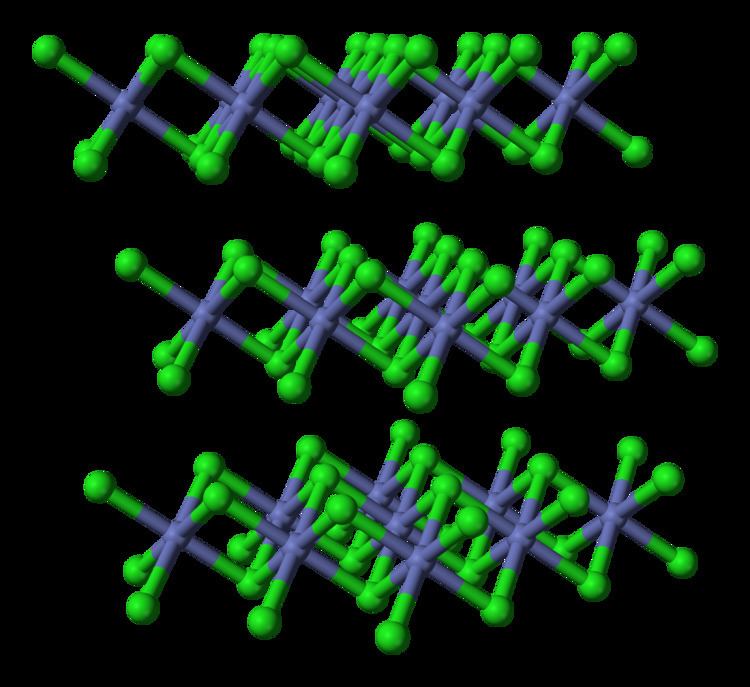Formula CoCl2 Density 3.36 g/cm³ Soluble in Water | Molar mass 129.839 g/mol Melting point 735 °C Boiling point 1,049 °C | |
 | ||
Appearance blue crystals (anhydrous)violet-blue (dihydrate)rose red crystals (hexahydrate) | ||
Equilibrium in cobalt ii chloride solution
Cobalt(II) chloride is an inorganic compound of cobalt and chlorine, with the formula CoCl2. It is usually supplied as the hexahydrate CoCl2·6H2O, which is one of the most commonly used cobalt compounds in the lab.
Contents
- Equilibrium in cobalt ii chloride solution
- Equilibrium in cobalt ii chloride solution temperature
- Properties
- Preparation
- Reactions
- CoIII derivatives
- Instability of CoCl3
- Safety
- In popular culture
- Other uses
- References
The hexahydrate is purple, whereas the anhydrous form is sky blue. Because of the ease of the hydration/dehydration reaction, and the resulting color change, cobalt chloride is used as an indicator for water in desiccants.
Niche uses of cobalt chloride include its role in organic synthesis and electroplating objects with cobalt metal.
Cobalt chloride has been classified as a substance of very high concern by the European Chemicals Agency as it is a suspected carcinogen.
Equilibrium in cobalt ii chloride solution temperature
Properties
Aqueous solutions of both CoCl2 and the hydrate contain the species [Co(H2O)6]2+. They also contain chloride ions. In the solid state CoCl2·6H2O consists of the molecule trans-[CoCl2(H2O)4] and two molecules of water of crystallization. This species dissolves readily in water and alcohol. Concentrated aqueous solutions are red at room temperature but become blue at higher temperatures. CoCl2·6H2O is deliquescent, and the anhydrous salt CoCl2 is hygroscopic, readily converting to the hydrate.
Preparation
Hydrated cobalt chloride is prepared from cobalt(II) hydroxide or cobalt(II) carbonate and hydrochloric acid:
CoCO3 + 2 HCl + 5 H2O → Co(H2O)6Cl2 + CO2Upon heating, the hexahydrate dehydrates.
Reactions
Generally, aqueous solutions of cobalt(II) chlorides behave like other cobalt(II) salts since these solutions consist of the [Co(H2O)6]2+ ion regardless of the anion. Such solutions give a precipitate of CoS upon treatment with H2S. CoCl2·6H2O and CoCl2 are weak Lewis acids. The adducts are usually either octahedral or tetrahedral. With pyridine (C
5H
5N), one obtains the octahedral complex:
With triphenylphosphine (P(C
6H
5)
3), a tetrahedral complex results:
Salts of the anionic complex CoCl42− can be prepared using tetraethylammonium chloride:
CoCl2 + 2 [(C2H5)4N]Cl → [(C2H5)4N)]2[CoCl4]The [CoCl4]2− ion is the blue ion that forms upon addition of hydrochloric acid to aqueous solutions of hydrated cobalt chloride, which are pink.
In the laboratory, cobalt(II) chloride serves as a common precursor to other cobalt compounds. Reaction of the anhydrous compound with sodium cyclopentadienide gives cobaltocene. This 19-electron species is a good reducing agent, being readily oxidised to the yellow 18-electron cobaltacenium cation. Reaction of 1-norbonyllithium with the CoCl2·THF in pentane produces the brown, thermally stable cobalt(IV) tetralkyl — a rare example of a stable transition metal/saturated alkane compound, different products are obtained in other solvents.
Co(III) derivatives
In the presence of ammonia or amines, cobalt(II) is readily oxidised by atmospheric oxygen to give a variety of cobalt(III) complexes. For example, the presence of ammonia triggers the oxidation of cobalt(II) chloride to hexamminecobalt(III) chloride:
4 CoCl2·6H2O + 4 NH4Cl + 20 NH3 + O2 → 4 [Co(NH3)6]Cl3 + 26 H2OThe reaction is often performed in the presence of charcoal as a catalyst, or hydrogen peroxide is employed in place of air. Other highly basic ligands including carbonate, acetylacetonate, and oxalate induce the formation of Co(III) derivatives. Simple carboxylates and halides do not.
Unlike Co(II) complexes, Co(III) complexes are very slow to exchange ligands, so they are said to be kinetically inert. The German chemist Alfred Werner was awarded the Nobel prize in 1913 for his studies on a series of these cobalt(III) compounds, work that led to an understanding of the structures of such coordination compounds.
Instability of CoCl3
The existence of cobalt(III) chloride, CoCl3, is disputed, although this compound is listed in some compendia. According to Greenwood and Earnshaw, the only stable binary compounds of cobalt and the halogens, excluding CoF3, are the dihalides. Stated differently, CoCl2 is unreactive toward Cl2. The stability of Co(III) in solution is considerably increased in the presence of ligands of greater Lewis basicity than chloride, such as amines.
Safety
In 2005–06, cobalt chloride was the eighth-most-prevalent allergen in patch tests (8.4%).
In popular culture
The NZ National Film Unit PICTORIAL PARADE No. 23 features cobalt chloride as the missing component in the pumicelands near Rotorua. Without this compound, no cattle would be able to survive on this land—only wild horses. [1]
